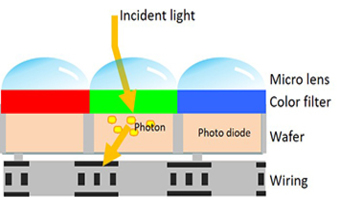On-chip color resists for image sensors

The image sensor is a semiconductor that converts the brightness of the light that enters the camera lens into electric signals.
Color filters are used not only in FPDs but also in image sensors built into smartphones and digital cameras. It has the same function of the retina in the human eye, and its performance significantly affects the image quality of photos taken with digital cameras.
By further enhancing our "nano-level dispersion processing technology," developed through color filter materials for FPDs, we are working on the development of on-chip color resists for image sensors. We are developing materials using pigments, dyes, etc. that are compatible with various wavelengths, including not only visible light but also near-infrared light.
- What is an image sensor?
- Structure of image Sensors
- Types of on-chip color filters
- Applications of Image sensors
- Required properties of on-chip color resists
- Our on-chip color resists
What is an image sensor?
Color filters are used not only for FPDs, but also for small chips (semiconductors) installed in smartphones, digital cameras, etc. This semiconductor is called an "image sensor" and has functions similarly to the retina of the human eye. By converting the light collected by a camera lens into an electrical signal, it becomes possible to reproduce it as an pictures or videos. Color filters have the function of separating the colors of the light that enters the image sensor and are important components that provide color information to images. Especially, the image quality of a digital camera is highly influenced by the performance of the "image sensor."
There are mainly two types of image sensors, CMOS and CCD. In the past, the two types of sensors were used in different applications according to their characteristics. CCD sensors, which has excellent image quality and little distortion, were often used for digital single-lens reflex cameras. On the other hand, CMOS sensors which have smaller power consumption and are easy to miniaturize, were often used for mobile phones and compact digital cameras. Nowadays, CMOS sensors that match the image quality of CCD sensors have been developed, so most cameras and smartphones now adopt the CMOS sensors.
Structure of an Image Sensor

Structure of image Sensors

Cross section of image sensor
The micro lens corresponds to a subpixel on the color filter and the corresponding color information (red, green or blue) will be given to the light transmitted through each part of the sensor. The light receiving element of the photo diode then detects the color and brightness, converts the information into electric signals, and finally records the scene as an image.
Other than the primary color filter (red, green, blue), there is also the complementary color filter (yellow, cyan, magenta, green) for on-chip color filters. These two types are used according to the purpose of the image sensor.
Types of on-chip color filters

Applications of Image sensors
Image sensors are installed not only in home appliances such as digital cameras and smartphones, but also in cameras for special applications such as surveillance cameras, in-vehicle cameras, and medical cameras. The sensor technology we have today is able to detect light beyond the visible region such as infrared rays, making the images that were once invisible, visible.
Security cameras

In-vehicle camera (ToF/3D-LiDAR)

Medical cameras

Required properties of on-chip color resists
As cameras become more sophisticated, color filters in image sensors are also required to have higher resolution. For example, in the case of a 55 inch Full Hi-Vision TV, the standard size per pixel is about 200μm X 600μm, but in the case of a smartphones, the size per pixel is about 1μm X 1μm. This is about 1 to 100,000 in terms of area ratio. As the size of each pixel becomes smaller, the negative effect of foreign objects on the image quality becomes greater. Therefore it is very important that the pigment particles in the on-chip color resists are made extremely small and are uniformly dispersed.

Conventional on-chip color filters could only sense colors in the visible region (400-700nm). However, as the versatility of image sensors expands, their applications and demands widen, such as being integrated into surveillance cameras and medical cameras. Consequently, filters capable of sensing various wavelengths of light, including infrared and ultraviolet, are being developed.
Our on-chip color resists
At our company, we have achieved nano-level pigments dispersion by utilizing the technology cultivated through the development of color filter materials for FPDs. We are also developing new dispersants to ensure stable dispersion even at high colorant concentrations. This allows the film thickness of color resist to be made even thinner.
Inquiries
TOYO VISUAL SOLUTIONS CO., LTD.
TEL:+81-3-3272-3457
